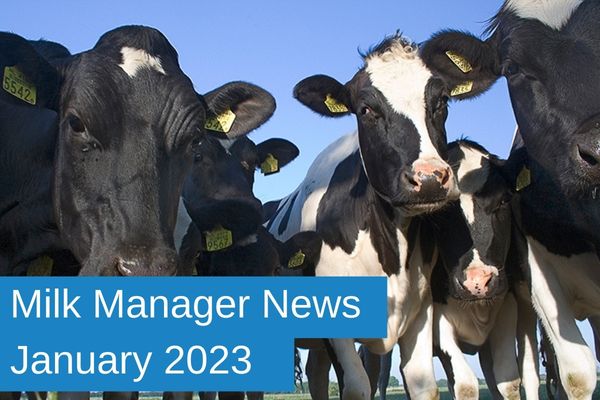Milk Manager News January 2023 – Key Performance Indicators for Measuring Fertility
13 January 2023Keeping up-to-date records and monitoring performance is key to identifying fertility issues within the herd. Addressing problems early on will keep you on track to meet your herd’s breeding and production targets. There are a variety of KPI’s (key performance indicators) which can be used to measure fertility, but which ones provide the most current and reliable feedback?
Calving Interval
Calving interval is the length of time between two calving events and is shown as an average across the milking portion of the herd. It is used on most farms as a benchmarking tool, and it shows how the herd was performing over 12 months ago.
Not only does this KPI fail to reflect present performance, but it also has the capacity to provide misleading results. A cow/heifer needs to have calved more than once before a figure can be generated, therefore any animals that fail to get back in calf are excluded from the calculation. By culling challenging cows, you can make the calving interval look better, whereas successfully getting repeat breeders back in-calf can make it look worse.
Target: Between 370-390 days
Conception Rate
This is the number of confirmed pregnancies, expressed as a percentage of the cows that were initially served. For example, if 10 cows were inseminated and 5 are confirmed in-calf, it would result in a conception rate of 50%.
This KPI can be useful for highlighting issues with stock bulls, the competency of the inseminators, or poor semen quality. However, what it fails to show is the farm’s ability to identify cows in heat. High conception rates don’t always mean good heat detection rates. Serving more ‘questionable’ cows may result in lower conception rates but could result in more pregnancies overall.
Target: >35%
Heat Detection Rate
Also known as submission rate, heat detection rate is the number of cows that are inseminated as a percentage of those that are eligible to be served. Eligible cows have gone beyond the voluntary waiting period, aren’t considered to be a cull cow, and haven’t already been confirmed in-calf. If there are 30 cows eligible to be served in a 3-week period, and 20 of those are inseminated, it would result in a heat detection rate of 67%.
It provides quick feedback on the farm’s ability to detect heat in cows but does not take into account pregnancy success.
Target: >65%
21-Day Pregnancy Rate
Probably the most effective way of monitoring fertility, the 21-day pregnancy rate combines how many cows were eligible to be served, and how many pregnancies were generated for each 3-week period. For example, if 30 cows were eligible to be served, and of those inseminated 6 resulted in a pregnancy, this would result in a pregnancy rate of 20%.
It provides an ongoing and a relatively up-to-date insight into both the ability to detect heat and pregnancy success on farm. However, different software packages may display slightly different results. This is due to how the program divides the calendar into 21-day intervals and the assumptions it will make regarding non-return rates.
Target: 20% AYR calving. 30% block calving
Average Days to First Service
This indicates how long it takes for cows to return to normal cycling behaviour after calving. Problems such as metritis, anoestrous (not displaying signs of heat) and ovarian cysts will impact when cows receive their first service. Differing voluntary waiting periods and misinterpreted heats may lead to unreliable results.
Target: between 60-80 days
Percentage Pregnant at Pregnancy Diagnosis
Ideally, at least, 70% of animals selected for pregnancy diagnosis would be confirmed in-calf (if chosen cows are between 32-39 days since last service). Farms that scan less frequently, presenting longer dated animals at scanning should aim for results in excess of 80%.
Non-Return Rate
Measuring non-return rate can give an early indication of heat detection and conception issues. Ideally 75% of cows that fail to conceive would be inseminated within the next service interval.
In conclusion, the KPI that provides the most effective overview of herd fertility is the 21-day pregnancy rate, closely followed by the non-return rate, which will give the earliest indication of arising problems. Using farm management software to measure conception rates from individual sources, such as batches of semen or groups of cows can help narrow down fertility issues to specific causes.
marcus.fox@sac.co.uk; 01539 889990
Sign up to the FAS newsletter
Receive updates on news, events and publications from Scotland’s Farm Advisory Service

